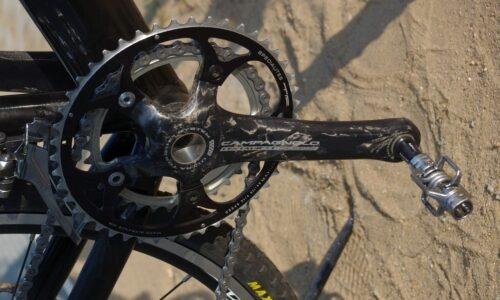The rear derailleur is the heart of a multi-speed bicycle drivetrain. A high-quality, properly fitted and adjusted derailleur will ensure crisp and accurate gear shifts that make your riding experience enjoyable and allow you to pick the right gears as your terrain grade varies over the course of any given ride.
The rear derailleur has a twofold function: to shift gears, and keep the chain under tension using a system of springs and pulley wheels.
Modern mountain bike rear derailleurs come in a variety of designs and compatibility options and benefit from many innovative technologies such as lighter materials, chain retention mechanisms, shifting systems (mechanical vs electronic) and low-profile bodies that tuck them out and away from direct hits on various trail objects.
In this article we look at the top choices for mountain bike rear derailleurs on the market today.
Top 9 mountain bike rear derailleurs
1. Shimano XTR M9120 rear derailleur
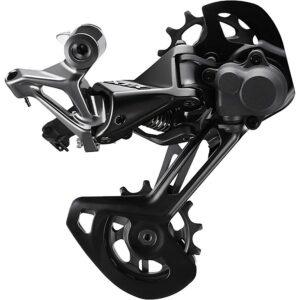
The XTR range of mountain bike components from Shimano is the top-tier of off-road bicycle parts the renowned Japanese manufacturer makes, and it has a legendary reputation of superior quality, reliability and innovation.
The XTR M9120 holds true to this reputation. This derailleur is designed for 12-speed drivetrains coupled with a double chainring crankset, offering a super wide range of gears for a wide variety of off-road riding scenarios.
This derailleur comes with oversized 13t pulley wheels, making it better at handling sudden shifts under pedaling load than its predecessors. Shimano’s Shadow+ technology, which is essentially a friction clutch at the main pivot point of the derailleur, ensures superior chain retention on rough trails.
2. SRAM NX Eagle rear derailleur
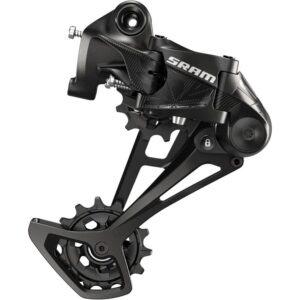
The NX rear derailleur sits two notches down on SRAM’s 11-speed mountain bike groupset hierarchy, preceded by the more premium GX and X01 derailleurs. The difference is mainly in the materials used, as SRAM uses a mix of steel and aluminum alloy in the NX whereas the more expensive siblings use a lighter all-aluminum construction.
That said, the NX rear derailleur offers the same crisp shifts you’d expect from SRAM’s state-of-the-art Eagle X01 derailleur albeit at a much more affordable price point.
If you want to upgrade to a 11-speed SRAM drivetrain without breaking the bank, the NX Eagle derailleur should be strongly considered.
3. Box One Prime rear derailleur

Box is not a cycling components household name like the big two, Shimano and SRAM, but they make some interesting drivetrain components that have proven to be strong contenders in this market.
The Box One Prime rear derailleur is compatible with 9-speed wide-range mountain bike cassettes and comes with very respectable specifications when to comes to weight and features. Many riders do not need 11 or 12 speeds for the type of terrain they ride, but still want the option of that wide-range gearing for the more challenging climbs.
If 9 speeds are all you need and you want an affordable, reliable rear derailleur, the Box One Prime may be the right rear derailleur for your bike!
4. SRAM Eagle AXS X01 rear derailleur

This 12-speed derailleur from SRAM is among, if not at the very top of, the cream of the crop of mountain bike rear derailleurs on the market today. If you’re building up a cost-is-no-object mountain bike and want the best of the best, the Eagle AXS X01 should be a no brainer.
This completely wireless derailleur pairs with SRAM’s wireless shifter from the AXS family of components for a very clean cable-less look on your bike.
The Eagle AXS X01 derailleur can handle 12-speed cassettes up to 52t which would offer you all the gear rage you need to conquer the steepest of climbs.
5. Shimano GRX rear derailleur

The Shimano GRX is not a mountain bike rear derailleur, but we decided to include it on this list due to the in-between nature of gravel bikes as well as their soaring popularity.
Gravel bikes benefit from many of the features originally developed for mountain bikes, such as the ability to handle wide-range cassettes and the Shadow Plus (friction clutch) features that lessens the likelihood of chain drop on rough terrain. The GRX is a robust choice for your gravel bike with a DNA borrowed from Shimano’s mountain bike range.
6. Shimano XT Di2 M8050 rear derailleur
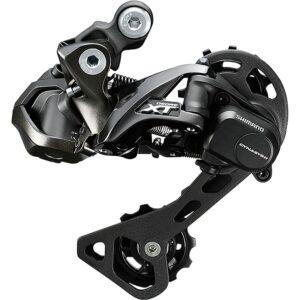
If you want to build a mountain bike with an electronic drivetrain without going way over budget, the Shimano XT Di2 M8050 is a solid choice. It’s not what you’d call cheap, but it is certainly much cheaper than the top of the line electronic derailleurs from Shimano and SRAM and offers the same functionality.
7. Shimano Alivio M3100 rear derailleur

For a no-frills mountain bike build on a strict budget, it is hard to find a better quality/price balance that Shimano’s Alivio range of budget components. This derailleur will offer you compatibility with 9-speed cassettes and double cranksets, but without Shimano’s more premium features (like Shadow Plus clutch) found on more expensive components.
If your riding is mostly done on gentler trails and don’t need compatibility with massive cassettes or fancy materials like light alloys and carbon fiber, the Alivio derailleur will offer you reliable, crisp shifting at a fraction of the cost of its more upscale siblings.
8. Shimano ZEE RD-M640 Shadow Plus Rear Derailleur

If you’re building up a dedicated downhill bike, the Zee rear derailleur from Shimano has a set of essential features for gravity sleds.
Compatibility with 10-speed cassettes, Shadow Plus friction clutch for chain retention, low-profile design keeps it out of harm’s way on high-speed rock-strewn trails and if you do break it in a crash, it doesn’t cost an arm and a leg.
9. Microshift Acolyte 8-Speed Rear Derailleur
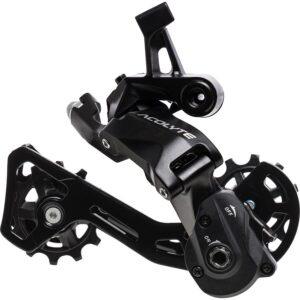
In a world of 11 and 12 speed bikes, 8 speeds may seem rather…inadequate? Not for everyone! It is important to remember that more speeds does not necessarily mean a better bike! Microshift is another under-the-radar name in the drivetrain world, but they make some reliable and very affordable components.
The Acolyte mountain bike rear derailleur is another great option for budget-oriented riders. The Acolyte is compatible with modern wide-range cassettes up to 46t and a chain retention system that Microshift calls SpringLock. Keep in mind that Microshift lists the Acolyte as compatible only with their Acolyte shifters and 8-speed cassettes, so mixing with components form other brands might be tricky here.
MTB Derrailleur Buying Tips
Check compatibility
If you’re upgrading just your rear derailleur, be certain the new rear derailleur you want to buy is compatible with the rest of your drivetrain components! While it is possible to mix components form different manufacturers, it is not always the case (e.g. some SRAM shifters work well with Shimano derailleurs, but not all!).
All manufacturers featured in this article have comprehensive manuals and/or compatibility charts, and there is a wealth of information in online cycling forums. Otherwise, your local bike shop should be your first port of call.
Shifting quality goes beyond the rear derailleur
If you want to upgrade your derailleur because you’re experiencing shifting issues, check that it’s not something related to other components first. Your gear indexing might need readjustment, or your cables might need replacement.
Shimano vs SRAM vs others
The obvious choices are the big two: Shimano or SRAM. Both companies make well-designed and high-quality components, so don’t overthink it but also don’t rule out smaller and less famous manufacturers who make innovative bike parts.
Clutches: do you need them?
Depends. Do you ride very rough terrain on your mountain bike? If yes, then we highly recommend sticking with clutched rear derailleurs. If your bike doesn’t see much action beyond smoother trails and bike paths, simpler and cheaper derailleurs might be adequate.
Weight, does it matter?
Again, that depends. The difference in weight between, say, an XT and XTR rear derailleurs is very small and the functionality is identical. If you are an XC racer, saving a few grams here and there may count for some marginal gains, but for most casual riders, the minor weight savings are not worth the significant price difference.
Conclusion
The rear derailleur is over a century old now, but it has come a long way. Modern mountain bike rear derailleurs have made leaps and bounds in the gear ranges they’re able to handle, durability as well as the reliability and precision of the shifting action.
With so many options from several manufacturers on the market today, you will have no difficulty finding the derailleur that best fits your bike and type of riding that you enjoy doing.

Hani Morsi is a seasoned multi-discipline cyclist with a particular liking for mountain and gravel bikes. Hani is also a mountain bike coach, trail builder and experienced bike mechanic.


